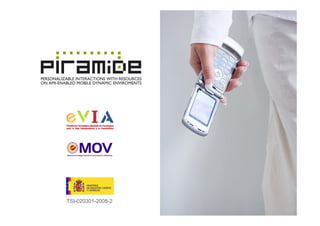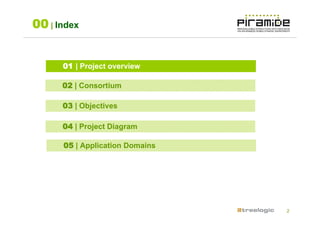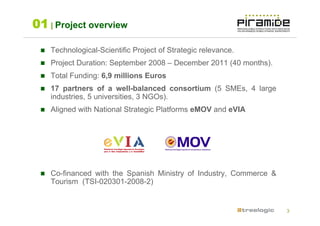PIRAmIDE English Presentation
- 2. 00 | Index 01 | Project overview 02 | Consortium 03 | Objectives 04 | Project Diagram 05 | Application Domains 2
- 3. 01 | Project overview Technological-Scientific Project of Strategic relevance. Project Duration: September 2008 ¨C December 2011 (40 months). Total Funding: 6,9 millions Euros 17 partners of a well-balanced consortium (5 SMEs, 4 large industries, 5 universities, 3 NGOs). Aligned with National Strategic Platforms eMOV and eVIA Co-financed with the Spanish Ministry of Industry, Commerce & Tourism (TSI-020301-2008-2) 3
- 4. 00 | Index 01 | Project overview 02 | Consortium 03 | Objectives 04 | Project Diagram 05 | Application Domains 4
- 5. 02 | Consortium 5
- 6. 00 | Index 01 | Project overview 02 | Consortium 03 | Objectives 04 | Project Diagram 05 | Application Domains 6
- 7. 03 | Objectives The main objective of PIRAmIDE is to analyze, define, implement and exploit the capabilities of mobile devices (Phones, PDA, ect.) as tools capable to sensor and capture of information and services related to objects we daily interact with. PIRAmIDE will deliver the needed infrastructure to make the mobile devices be catalyst of the interactions with the objects of everyday life (home, office and free time). 7
- 8. 03 | Objectives Project Piramide mission is to transform our mobile devices in a sort of Sixth Sense The project envisages that these devices will assist us and act on our behalf easing our daily interactions with the objects of everyday life, at home, at wok or in our free time. The growing sensor, computational and communicational capabilities of mobile devices make them the ideal candidate for the purpose described above. Moreover these capabilities can be adapted in order to serve and help the limited capabilities of disabled people with problems of mobility, sight and earring. 8
- 9. 03 | Objectives UsersˇŻ dynamic environment Mobile Devices Users Information Modelling Contextual Reasoning Multimodal Interaction Sensors 9
- 10. 03 | Objectives Environments Users Dynamic Characteristics They ask information Sensors Services depending on the context They provide contents Usability and services Interactions with the environment Heterogeneous networks 10
- 11. 00 | Index 01 | Project overview 02 | Consortium 03 | Objectives 04 | Project Diagram 05 | Application Domains 11
- 12. 04 | Project Diagram SP8: EXPLOITATION AND DISSEMINATION 12
- 13. 00 | Index 01 | Project overview 02 | Consortium 03 | Objectives 04 | Project Diagram 05 | Application Domains 13
- 14. 05 | Applications Domains UsersˇŻ dynamic environment Applications Domains e-Inclusion: Users Mobile devices Contents Services e-Health/ e-Wellness: Contents Services 14
- 15. COORDINATOR















